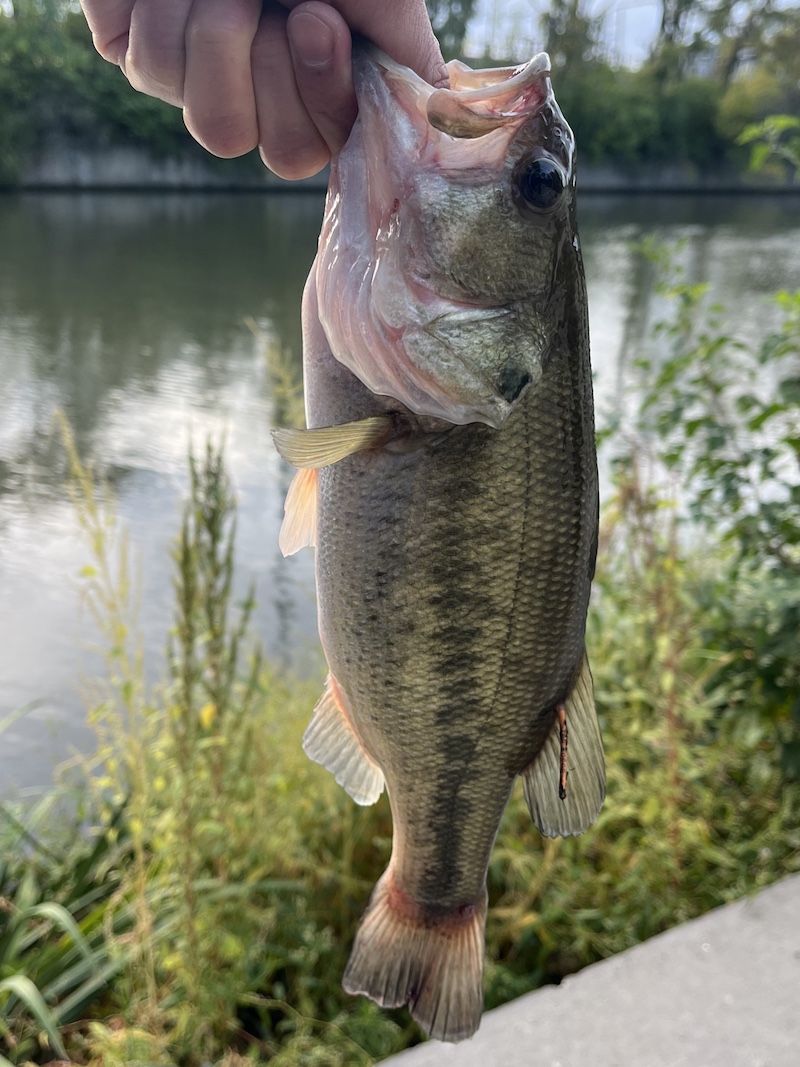
Photo courtesy of Leif Gregory and Bella Fishman.



Photo courtesy of Leif Gregory and Bella Fishman.
In 2024, Shedd Aquarium partnered with the Illinois Department of Natural Resources (IDNR) and the U.S. Army Corps of Engineers (USACE) to learn more about largemouth bass in the Chicago River—with the aid of anglers.
The team marked fish using FLOY tags that look similar to clothing tags. These plastic tags are fast to put on the fish, easy to see when the fish is caught, and the plastic allows researchers to print contact information and individual numbers on each tag. This individual numbering system allows us to see where and when each fish was tagged or encountered when anglers catch them. Now, anglers may participate in the ongoing study by reporting when they encounter these tagged fish, helping fisheries managers gain a new understanding of the local population of largemouth bass.

Recent work by Shedd Aquarium’s Dr. Austin Happel looking into data collected by the Metropolitan Water Reclamation District of Greater Chicago (MWRD) has indicated that the number of largemouth bass encountered in standardized surveys increased in the 1990s but has remained rather stagnant since then. For a few years since 2015 the number of bass increased in their surveys, however at most one fish per survey was more than 1 foot in length. The low number of larger bass suggests that the abundant younger bass are not living to older ages or larger sizes. Over the decades of the MWRD surveys, the largest largemouth bass found each year has consistently been approximately 16 inches and are all less than 3.2 pounds—save the 19-inch, 4.78-pound one found near the Chicago Harbor Lock in 1995—likely came through the lock from Lake Michigan. While lakes and reservoirs are capable of producing trophy largemouth bass greater than 20 inches and more than 10 pounds, out of a river anything approaching 5.0 pounds or more would be considered memorable. Tournament results in the Calumet region demonstrate that largemouth bass approximately 5 pounds are possible in these urban waterways. We find it interesting that the Chicago River population does not seem to be producing larger largemouth bass, and we are investigating why this may be to see if it is possible to change this.

Each spring and fall for the last 14 years, IDNR and USACE survey crews have sampled 30-some sites throughout the North and South Branches of the Chicago River. Each summer for 40 years, MWRD has sampled routinely five locations. While these surveys can give rough ideas of how many bass are living in an area, tagging individuals can help us estimate population densities, home ranges and preferred habitats. In 2024, a total of 660 largemouth bass from the Chicago River were tagged with individual identification numbers.

Anglers are out fishing throughout the year, across much of the river, and far outnumber biologists. Angler reports frequently occur in areas where surveys do not occur. For example, as part of a separate study in 2019, a tagged bass was found by an angler near Skokie Lagoons, a section of the river not sampled by the survey crews. Angler reports also occur over the winter and summer periods, filling in gaps in time between surveys and allowing a view into what habitats the fish prefer throughout the year.
So far, 25 different anglers have reported 37 captures of tagged bass. Most reports of tagged bass have occurred within 1.5 miles of where the fish was tagged, but some were found up to 11 miles away.
Angler reports have occurred throughout the North and South Branches of the Chicago River, with River Park, Park 571 and the Wilmette Pumping Station area being common sites for reports. Only one fish has been captured multiple times, a fish was caught three times across a 6 month period by three different people.

There are several factors that may explain why larger largemouth bass are not detected in the Chicago River. The Chicago River lacks a lot of structural habitat—things like submerged vegetation, downed trees and limbs, rocks and boulders—that largemouth bass like to hang out around and stalk their prey from. The sediment has accumulated contaminants and pollutants for nearly two centuries, so offering non-contaminated gravel areas could help provide areas for bass to build nests. Crayfish are a major component of the diets of very large largemouth bass and crayfish populations may be hindered by the abundant bulkhead steel walls which prevent burrow creation.
Another factor could be that this urban waterway has multiple water quality stressors. The primary source of water for the Chicago River is the O’Brien Water Reclamation Plant and two other discharges of treated wastewater effluent from Lake County. Each Branch and tributary of the Chicago River brings urban runoff into the system and periodically heavy rainfall events cause combined sewer overflows into the system. All of these, quite literally, carry with them complex mixtures of chemicals and compounds which can have negative effects on aquatic life.
Learning more about the largemouth bass in the Chicago River can help us identify which factors might be worth addressing first so we can have more and larger largemouth bass in the river. These tagged bass represent one piece of the puzzle, allowing us to better understand population density, individual’s movements, and common habitats they are found in throughout the river system.

Anglers are invited to participate in helping collect important data when they catch a tagged fish. The tags have an email address on them, where you can submit the individual tag ID number, the location and date. Your reports will greatly assist in the research team’s efforts to understand the Chicago River and its largemouth bass population.
Since 2019 Dr. Austin Happel has been researching the Chicago area waterway system with Shedd Aquarium. His current research projects involve identifying where certain species are and are not found, comparing those different habitats so that we can then inform restoration projects. Happel aims to use the Chicago River as an example of an altered river system which has shown resilience, if restoration projects can have positive outcomes here there is hope for projects in other urban rivers.
Envíe una pregunta para el autor
Question: I recently caught a female large mouth bass which is tagged.